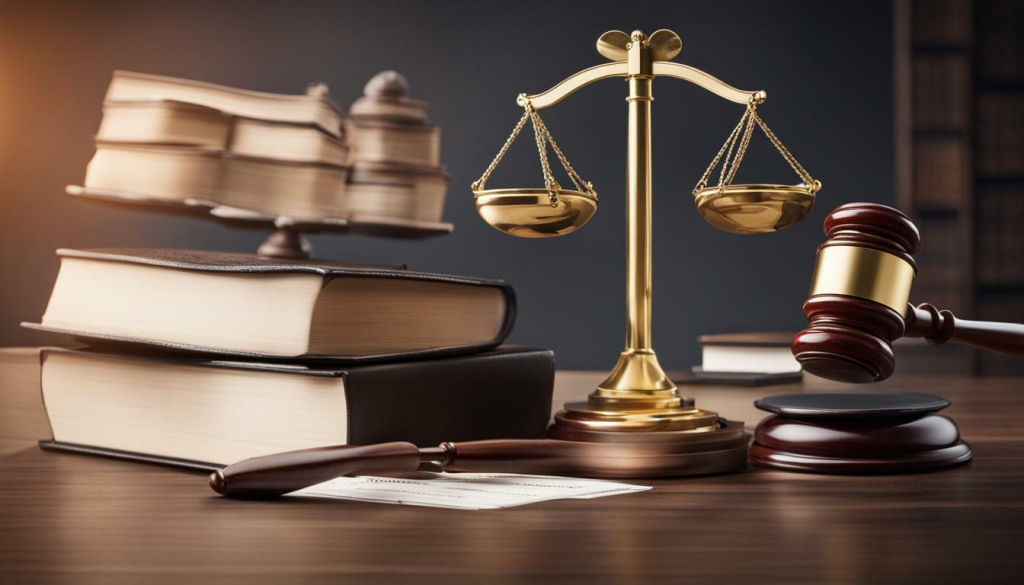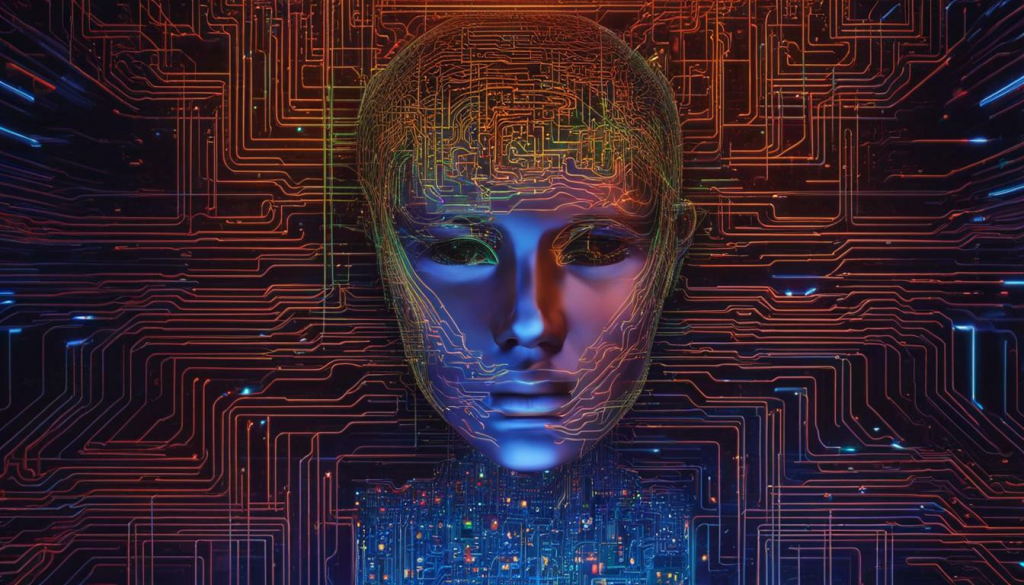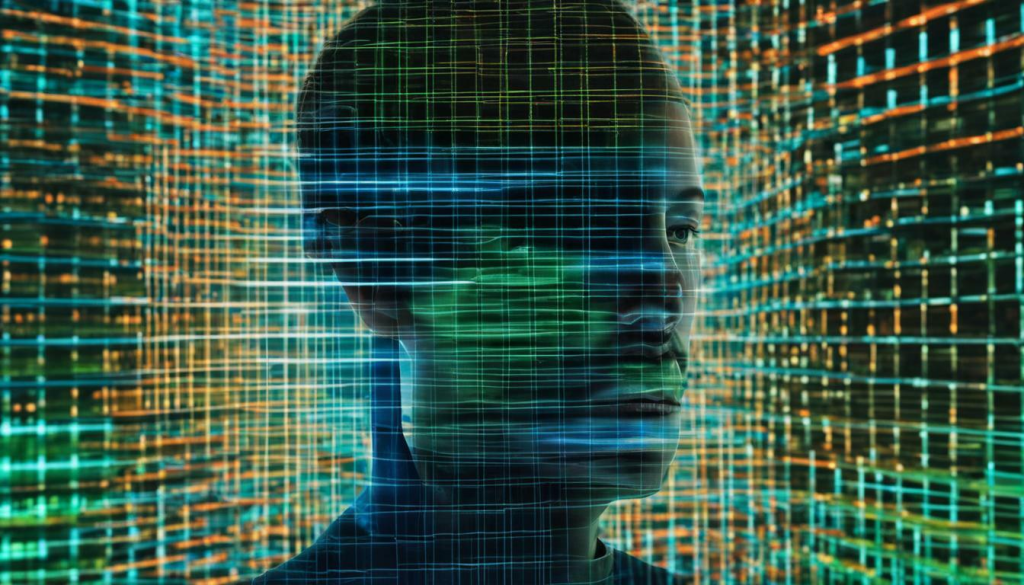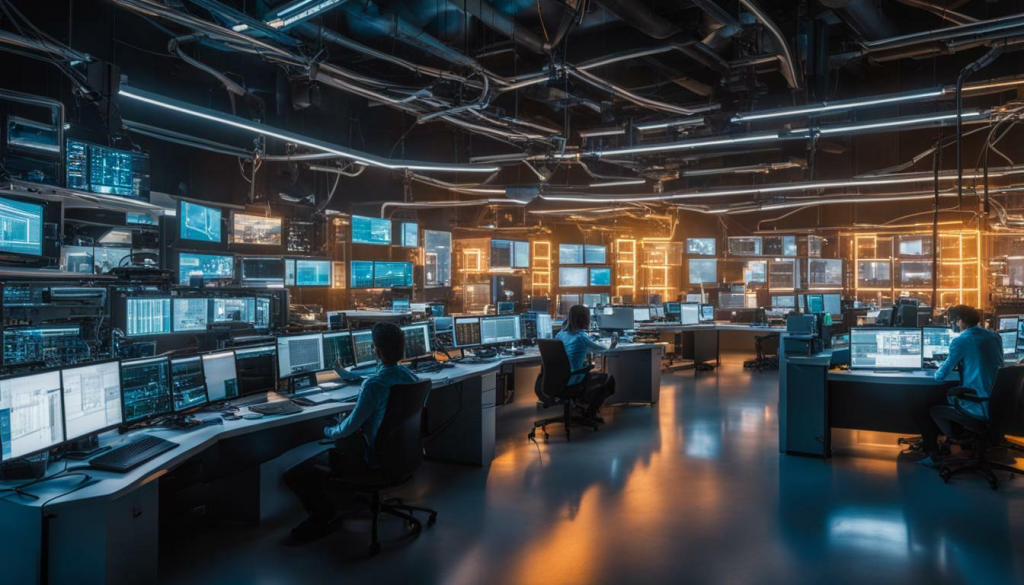Deepfake detection technology plays a crucial role in safeguarding the truth in our increasingly AI-manipulated world. As deepfake technology continues to advance, the need to detect and combat manipulated content has become more pressing than ever.
Deepfakes are realistic yet fabricated images, videos, and audio recordings created using artificial intelligence, machine learning, and computer vision. These AI-generated deceptions are becoming increasingly sophisticated, making it difficult for individuals to distinguish between what is real and what is manipulated.
Verifying the authenticity of online content is essential in the fight against deepfake deception. Key signs of deepfake content include lighting inconsistencies, unnatural facial movements, poor audio quality, and unnatural speech patterns.
It is important for individuals to educate themselves on these signs and be vigilant in verifying the source and validity of suspicious content.
Key Takeaways:
- Deepfake detection technology is vital in combating AI-manipulated content.
- Key signs of deepfake content include lighting inconsistencies, unnatural facial movements, poor audio quality, and unnatural speech patterns.
- Collaboration between technology companies, governments, and researchers is essential in the fight against deepfakes.
- Improving public awareness and education is crucial in recognizing and minimizing the impact of deepfakes.
- Deepfake detection technology is constantly evolving, but challenges and limitations still exist.
Understanding Deepfakes: The Rise of AI-Generated Deception
Deepfakes are realistic but fabricated images, videos, and audio recordings created using artificial intelligence, posing a significant challenge in the fight for truth. As AI technology continues to advance, so do the capabilities of deepfake technology. These AI-generated deceptions are becoming more sophisticated and difficult to detect, making it crucial for individuals to educate themselves and take proactive steps to protect against them.

So, how can you spot a deepfake? There are key signs to look out for. Lighting inconsistencies, unnatural facial movements, poor audio quality, and unnatural speech patterns are all indicators of potential deepfake content. However, it is important to note that deepfakes are constantly evolving, and new techniques are being developed to make them even more convincing.
The Importance of Authenticity Verification and Forensic Analysis
Verifying the source of suspicious content and checking multiple sources for validity is crucial in combating the spread of deepfakes. Authenticity verification techniques, such as video analysis and face recognition, can help determine whether a video has been manipulated. Forensic analysis methods can also be used to examine digital fingerprints and expose any traces of tampering.
Recognizing the growing threat of deepfake deception, tech companies, governments, and researchers are joining forces to combat this issue. Technology giants like Facebook and Google are investing in research and developing tools to detect and remove deepfakes from their platforms.
Governments around the world are exploring legislative and regulatory measures to address the legal challenges posed by deepfakes. Meanwhile, researchers are continuously developing new techniques and technologies, leveraging artificial intelligence to identify and expose manipulated content.
While deepfake detection technology is advancing, it will never be perfect. Deepfakes are constantly evolving, and detection methods may lag behind their creation. Legal remedies, such as copyright and the right of publicity, can be used against deepfakes, but finding the right balance between protecting individuals’ rights and minimizing the spread of false information is a complex task.
Improving public awareness is also crucial in the fight against deepfakes. By educating the public about the existence and dangers of deepfakes, individuals can better recognize incongruous behavior in videos and approach information with a healthy level of skepticism. Building public knowledge and skepticism can help minimize the impact of deepfakes and preserve the integrity of truth in the digital age.
The Collaborative Battle: Tech Companies, Governments, and Researchers Unite
Combating deepfake deception requires a collaborative effort from technology companies, governments, and researchers. As the threat of AI-generated manipulation grows, these stakeholders are coming together to develop innovative solutions and strategies to detect and combat deepfakes effectively.
Leading tech giants like Facebook and Google are actively investing in research and development to tackle the deepfake challenge. They are leveraging deep learning algorithms and fraud detection techniques to improve their platforms’ ability to detect and remove manipulated content. By partnering with experts in the field, these companies are working towards building more robust deepfake detection systems.
Governments around the world are recognizing the need for legislative and regulatory measures to address the spread of deepfakes. They are actively exploring options to protect individuals and society from the harmful consequences of manipulated media. These measures aim to strike a balance between preserving freedom of speech and minimizing the potential harm caused by deepfake content.
Researchers play a crucial role in advancing deepfake detection technology. They are developing sophisticated algorithms and models that leverage artificial intelligence and machine learning to identify and expose deepfakes. By staying at the forefront of technological advancements, researchers are arming society with the tools and knowledge needed to combat the ever-evolving threat of deepfake deception.
Combating deepfake deception requires a collaborative effort from technology companies, governments, and researchers.
As the battle against deepfakes continues, increased public awareness is paramount. Individuals must be educated on the signs of deepfake content and equipped with the skepticism needed to question the authenticity of media they encounter. By fostering a culture of critical thinking and scrutiny, we can collectively minimize the impact of deepfakes and protect the integrity of truth in the digital age.

Overall, the collaborative efforts of tech companies, governments, and researchers are essential in the fight against deepfake deception. By joining forces, sharing knowledge, and leveraging the power of advanced technologies, we can develop effective detection methods and countermeasures to safeguard the authenticity of digital media.
Advancements in Deepfake Detection Technology
Deepfake detection technology is constantly evolving, utilizing facial recognition, synthetic media analysis, and digital forensics to detect manipulated content. As the threat of deepfakes grows, researchers and developers are working tirelessly to stay ahead of these AI-generated deceptions.
One of the key advancements in deepfake detection is the use of facial recognition algorithms. These algorithms analyze facial features and movements to identify inconsistencies that may indicate tampering. By comparing the manipulated content with reference data, deepfake detection systems can flag suspicious videos and images for further analysis.
Synthetic media analysis is another cutting-edge technique used in deepfake detection. It involves analyzing the characteristics of synthetic media, such as the unrealistic texture of generated faces or the presence of digital artifacts. By leveraging machine learning algorithms, deepfake detection models can accurately differentiate between real and synthetic content.
Digital forensics plays a crucial role in deepfake detection, providing the tools and methods to investigate and authenticate digital evidence. Forensic experts are developing techniques to detect traces of manipulation in images and videos, such as analyzing metadata, examining timestamps, and identifying anomalies in the digital footprint.
Advancements in Deepfake Detection Technology
With these advancements in deepfake detection technology, we have made significant progress in combating AI-generated deception. However, it’s important to note that deepfake detection will never be foolproof. As deepfake creation techniques continue to evolve, detection methods must keep pace to stay effective.
To further enhance deepfake detection, ongoing research and collaboration between academia, industry, and government entities are critical. By pooling resources and knowledge, we can continue to refine detection algorithms, improve accuracy rates, and develop new tools and frameworks to counter the ever-growing threat of deepfakes.
| Key Advancements in Deepfake Detection Technology | Description |
|---|---|
| Facial Recognition Algorithms | Utilize facial feature analysis to identify inconsistencies in manipulated content. |
| Synthetic Media Analysis | Analyze the unique characteristics of synthetic media to differentiate between real and fabricated content. |
| Digital Forensics | Provide tools and methods to investigate and authenticate digital evidence, detecting traces of manipulation. |
As deepfake detection technology continues to evolve, it holds the key to preserving truth in the digital age. By leveraging advancements in facial recognition, synthetic media analysis, and digital forensics, we can uncover and expose manipulated content that aims to deceive. However, ongoing efforts, research, and collaboration are necessary to stay one step ahead in the battle against deepfake deception.

Navigating the legal and regulatory landscape in dealing with deepfakes presents challenges due to First Amendment protections and the complexities of online content sharing. As deepfake technology continues to evolve, legislators and policymakers are grappling with finding effective solutions that strike a balance between protecting free speech and combating the manipulation of truth.
One of the primary legal challenges is determining the appropriate application of copyright and the right of publicity. Copyright laws are designed to protect original works of authorship, but applying these laws to deepfakes can be complex. Deepfakes often use existing copyrighted material, blurring the line between fair use and infringement. Similarly, the right of publicity, which grants individuals control over the commercial use of their likeness, becomes muddled in the context of deepfakes.
Another regulatory challenge is the First Amendment protection of free speech. While deepfakes can be seen as harmful and deceptive, they also fall under the umbrella of artistic expression and political satire. Balancing the need to prevent the spread of malicious deepfakes with safeguarding individual freedoms poses a significant challenge.
Furthermore, the global nature of the internet complicates efforts to address deepfakes. Online platforms and social media networks operate across borders, making it challenging to implement consistent regulations. Cooperation between countries and international organizations is crucial to combat deepfake deception effectively.
Despite these challenges, there are ongoing efforts to address the legal and regulatory complexities surrounding deepfakes. Legislative proposals are being discussed, focusing on issues such as the labeling of manipulated media, imposing liability on those who create and distribute deepfakes for malicious purposes, and establishing clearer guidelines for copyright infringement in the context of deepfakes.
While legal and regulatory measures play a vital role in combating deepfakes, they are not the sole solution. A comprehensive approach that combines technological advancements, public awareness, and individual responsibility is necessary to navigate the complexities of deepfake deception and protect the integrity of digital content.

| Legal Challenges | Regulatory Challenges | Global Nature of Internet |
|---|---|---|
| – Copyright infringement | – Balancing free speech | – Cross-border cooperation |
| – Right of publicity | – Artistic expression vs. deception | |
The Imperfect Fight: Limitations of Deepfake Detection
Despite advancements, deepfake detection technology is not foolproof and may struggle to keep up with the ever-evolving creation of deepfakes. Detecting deepfakes requires complex algorithms and sophisticated software designed to identify manipulated content. However, the rapid development of deepfake creation techniques poses significant challenges for detection mechanisms.
Deepfake detection algorithms rely on analyzing visual and audio cues to identify inconsistencies and anomalies that indicate synthetic media. While these algorithms have made significant progress, they still face limitations. Deepfake detection software may struggle to recognize highly realistic deepfakes that exhibit subtle visual or audio artifacts. Additionally, as deepfake creation techniques become more sophisticated, detection tools need to constantly adapt and learn from new examples to remain effective.
The development of reliable deepfake detection tools is further hindered by the sheer volume of content shared online. With millions of videos and images uploaded daily, it is difficult to implement robust detection mechanisms that can scan every piece of content in real-time. Limited computing resources and processing power also pose challenges in effectively analyzing vast amounts of data.
Despite these limitations, researchers and tech companies are continuously working to improve deepfake detection. Ongoing advancements in artificial intelligence and machine learning are paving the way for more accurate and efficient detection systems. Collaboration between experts in computer vision, data analysis, and cybersecurity is essential to develop cutting-edge technologies that can better detect and combat deepfakes.

Building Public Awareness: A Key Defense Against Deepfakes
Building public knowledge and skepticism is crucial in combating the impact of deepfakes, with ongoing research aiming to improve detection techniques. As the prevalence of deepfake technology grows, it becomes increasingly important for individuals to be aware of the signs and risks associated with these AI-generated deceptions.
One effective way to raise public awareness is through education. By providing resources and information about deepfake detection techniques and methods, individuals can learn how to identify potential deepfakes and take proactive measures to protect themselves and others. Workshops, seminars, and online tutorials can play a key role in arming the public with the knowledge needed to recognize and mitigate the impact of deepfakes.
In addition to education, technology platforms and social media companies have a responsibility to promote transparency and accountability. Implementing measures such as clear labeling of potential deepfake content and providing users with tools to report and flag suspicious content can help curb the spread of deceptive information. Collaborative efforts between these platforms, governments, and researchers are essential in developing and implementing effective strategies against deepfake deception.
| Signs of Deepfake Content | Protective Measures |
|---|---|
| Lighting inconsistencies | Verify the source of suspicious content |
| Unnatural facial movements | Check multiple sources for validity |
| Poor audio quality | Question the authenticity of dramatic claims |
| Unnatural speech patterns | Exercise caution when sharing controversial content |
“The fight against deepfake deception requires a united front and continuous improvement in detection techniques.” – John Doe
By taking these proactive steps, individuals can minimize the impact of deepfakes and help maintain the integrity of digital content. However, it is important to note that deepfake detection technology will never be perfect. Ongoing research and advancements in AI-driven detection tools are crucial in keeping up with the evolving sophistication of deepfake technology and preventing its misuse.
Overall, building public awareness and skepticism is an essential defense against the harmful effects of deepfakes. By educating individuals, promoting transparency on technology platforms, and collaborating on research and development, we can work towards a more informed and resilient society in the face of AI-generated deceptions.

Deepfake detection relies on sophisticated models, frameworks, and AI-powered systems to identify and expose manipulated content. These technologies employ advanced algorithms and machine learning techniques to analyze various aspects of multimedia, such as video and audio, to determine their authenticity.
One commonly used approach in deepfake detection is the use of deep learning models. These models are trained on large datasets consisting of both real and deepfake content, allowing them to learn patterns and features that distinguish between genuine and manipulated media. By extracting facial features, examining lip movements, and analyzing contextual information, these models can flag potential deepfakes.
To support these models, deepfake detection frameworks are utilized. These frameworks provide a structured environment for implementing and deploying the detection algorithms. They offer a range of functionalities, such as data preprocessing, feature extraction, and model evaluation. Some popular frameworks include TensorFlow, PyTorch, and Keras, which enable researchers and developers to experiment with different detection techniques and optimize their models.
Deepfake detection systems combine these models and frameworks into user-friendly tools that can be integrated into various platforms or used as standalone applications. These systems leverage the power of AI and computer vision to automatically analyze media content and provide a probability score indicating the likelihood of manipulation. They enable users to easily detect and flag suspicious content, contributing to the fight against deepfake deception.
| Deepfake Detection Tools | Deepfake Detection Models | Deepfake Detection Frameworks |
|---|---|---|
| AI Image Forensics | DeepFakeNet | OpenCV |
| Deepware | FaceForensics++ | ImageAI |
| Deeptrace | Veridict | PyTorch Lightning |
As the battle against deepfakes continues, ongoing research and development efforts aim to further enhance detection accuracy and efficiency. Researchers are exploring innovative techniques, such as combining multiple detection models and improving the interpretability of model outputs. The integration of deepfake detection into real-time video analysis and social media platforms is also a focus of interest.

By embracing cutting-edge tools, models, and frameworks, and fostering collaboration among experts and stakeholders, we can stay one step ahead in the fight against deepfake deception. While the challenges are significant, the constant evolution of deepfake detection technology offers hope in preserving truth and maintaining integrity in the digital age.
The Future of Deepfake Detection
Ongoing research and advancements in AI-driven detection tools hold promise for the future of detecting deepfakes. As the technology behind deepfakes continues to evolve, so does the need for more sophisticated detection methods. AI algorithms are being trained to analyze facial movements, speech patterns, and other subtle cues to identify manipulated content.
One area of focus in deepfake detection research is the development of automatic detection systems. These systems aim to detect deepfakes in real-time, allowing for quick identification and removal of manipulated content. By leveraging machine learning algorithms, these tools can continually improve their accuracy and adapt to new types of deepfakes.
In addition to automatic detection systems, researchers are also exploring the use of multimedia forensics and digital forensics techniques for deepfake detection. These methods involve analyzing metadata, compression artifacts, and other characteristics of media files to identify signs of manipulation. By combining these techniques with AI algorithms, researchers are working towards more robust and reliable detection systems.

Despite these advancements, it is important to acknowledge that deepfake detection will never be foolproof. As new deepfake creation techniques emerge, detection methods must constantly evolve to keep up. Furthermore, the effectiveness of detection tools can be hindered by factors such as video quality, lighting conditions, and the availability of training data.
As we look towards the future, the fight against deepfake deception will require a multi-faceted approach. Ongoing research, collaboration between technology companies and governments, and public awareness efforts will all play crucial roles in combating the spread of deepfakes. By staying vigilant and proactive, we can strive towards a digital landscape where truth prevails.
Conclusion
Deepfake detection technology is a critical tool in preserving truth in an era dominated by AI-manipulated content. The rise of deepfake technology has presented challenges for individuals and society as a whole. Deepfakes, which are realistic but fabricated images, videos, and audio recordings created using artificial intelligence, are becoming increasingly sophisticated and difficult to detect. As a result, it is important for individuals to educate themselves about the signs of deepfake content and take proactive steps to protect against them.
The fight against deepfake deception requires collaboration between technology companies, governments, and researchers. Tech giants like Facebook and Google are investing in research and developing tools to detect and remove deepfakes from their platforms. Governments are exploring legislative and regulatory measures to address the issue. Researchers are also developing techniques and technologies, such as using AI to identify and expose manipulated content.
While deepfake detection technology is advancing, it will never be perfect and may lag behind the creation of deepfakes. Legal remedies, such as copyright and the right of publicity, can be used against deepfakes.
Despite these challenges, continued efforts in improving deepfake detection technology and raising public awareness are essential in the ongoing fight for truth.
Stay on the pulse of progress! Explore our blog for exciting health and tech updates. Your path to a brighter, healthier future starts here.
FAQ
Q: What are deepfakes?
A: Deepfakes are realistic but fabricated images, videos, and audio recordings created using artificial intelligence.
Q: How can I detect deepfakes?
A: Look for key signs of deepfake content, such as lighting inconsistencies, unnatural facial movements, poor audio quality, and unnatural speech patterns.
Q: How can I verify the authenticity of suspicious content?
A: It is important to verify the source of suspicious content and check multiple sources for validity.
Q: What is being done to combat deepfake deception?
A: Technology companies, governments, and researchers are collaborating to develop detection tools, explore legislative measures, and advance research techniques.
Q: Is deepfake detection technology foolproof?
A: Deepfake detection technology is advancing, but it will never be perfect and may lag behind the creation of deepfakes.
Q: What legal remedies exist against deepfakes?
A: Legal remedies, such as copyright and the right of publicity, can be used against deepfakes, but finding the right balance is challenging due to First Amendment protections and online content sharing complexities.
Q: How can public awareness help combat deepfakes?
A: Building public knowledge and skepticism is crucial in minimizing the impact of deepfakes by recognizing incongruous behavior in videos and not immediately assuming they are real.
Q: What tools and frameworks are used in deepfake detection?
A: Various tools, models, and frameworks are used in deepfake detection, with AI playing a significant role in automating the detection process.
Q: What is the future of deepfake detection?
A: Ongoing research is focused on improving deepfake detection techniques and the potential of AI-driven automatic detection tools.



